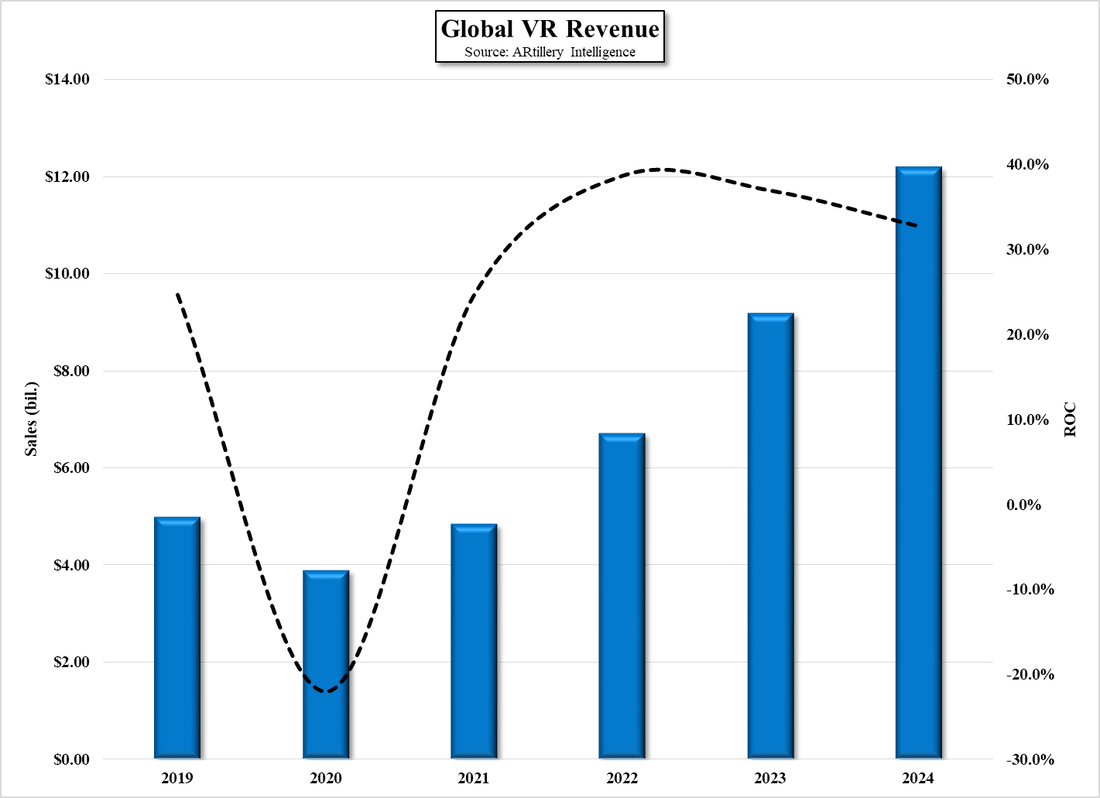Fun With Data – VR Displays
The initial consideration shown in the data, which includes only released headsets, is the number of VR headsets released each year. There was little activity after the 1994 release of the Forte (defunct) VFX1 headset, the first commercial headset we can find, that used a Kopin (KOPN) LCD display and a Sharp (6753.JP) video processor, until September of 2002 when Sony (SNE) released the PUD-15A (catchy name?) as a 3D headset for the Playstation, and NVIS (pvt) released a $24,000 headset (the nViser), which was considered a quasi-commercial device. Little commercial VR equipment was produced until 2013 when Oculus (FB), a Kickstarter funded company at the time, released the Oculus Rift DK1, an inexpensive LCD based VR headset, and followed it in 2014 with the Oculus Rift DK2, which was based on an OLED display. Facebook (FB) bought Oculus for $2.3b in 2014 and has partnered with a number of large CE companies using the Oculus platform as a basis for such branded VR products.
In 2015 Razer (1337.HK), currently a producer of PCs and smartphones and accessories, released the OSVR HDK (Hardware Development Kit), which allowed for enthusiasts to develop their own modifications to the headset, which was based on an OLED display. That same year 3Glasses (pvt) (aka Shenzhen Virtual Reality Technology Co.) released its first VR headset the D2, based on an LCD display. 2016 was a better year for VR as 8 headsets were released from a variety of small companies, and a number of large ones, such as LG Electronics (066570.KS), HTC (2498.TT), Sony, and Oculus, with the type of displays evenly split between OLED and LCD, however the resolution of these displays was still relatively low until 2018 when the first dual QHD (Wide Quad HD) display was released by VRgineers (pvt), a Czech based company that specializes in VR for pilot training. Since then the development of micro-LCD and micro-OLED displays for VR has increased and continued improvements have followed with a number of high resolution LCD models released in late 2020 and last year’s first micro-OLED headset from Arpara (pvt), that pushed VR display resolution and technology forward.
While we expect at least a dozen new VR headset releases this year, we also expect to see VR displays based on quantum dot enhanced LCD and both updated micro- LCD and Micro-OLED displays, however also expected is the first Mini-LED LCD display and an ultra-high resolution LCD display that would be more than double the resolution of the best released thus far. That said, we do note that there can be a big difference between when a VR headset is announced and when it is actually released, sometimes more than a year (and in some cases never, so we wait until such promises become actual products before including them in our ‘current’ VR database.
The objective in developing such high resolution displays is to reduce what is called the screen door effect, which occurs because of the space between pixels and can be both distracting to the user and confusing to the user’s brain causing fatigue. The spaces are hidden with a black ‘mask’ that separates the light from each pixel, but also creates the effect if the PPI (pixels/inch) is relatively low, especially when the displays are so close to the user’s eye. Companies have found ways around the problem by blurring pixels slightly but these are solutions that do not address the real problem, display resolution.
As display technology improves, resolution improves, which is absolutely necessary for VR and the Metaverse to become anything other than a toy for the dilettante, but such improvements in micro-displays are both difficult and costly, while headset volumes are relatively low when compared to other CE display products. With the focus on the Metaverse creating renewed interest in VR, we should see additional capital being spent on micro-display development, but such developments take time and the question remains as to whether the current enthusiasm over the Metaverse will last long enough for the next level of micro-display development or will we have to wait for Metaverse 2.0 a few years forward?



 RSS Feed
RSS Feed